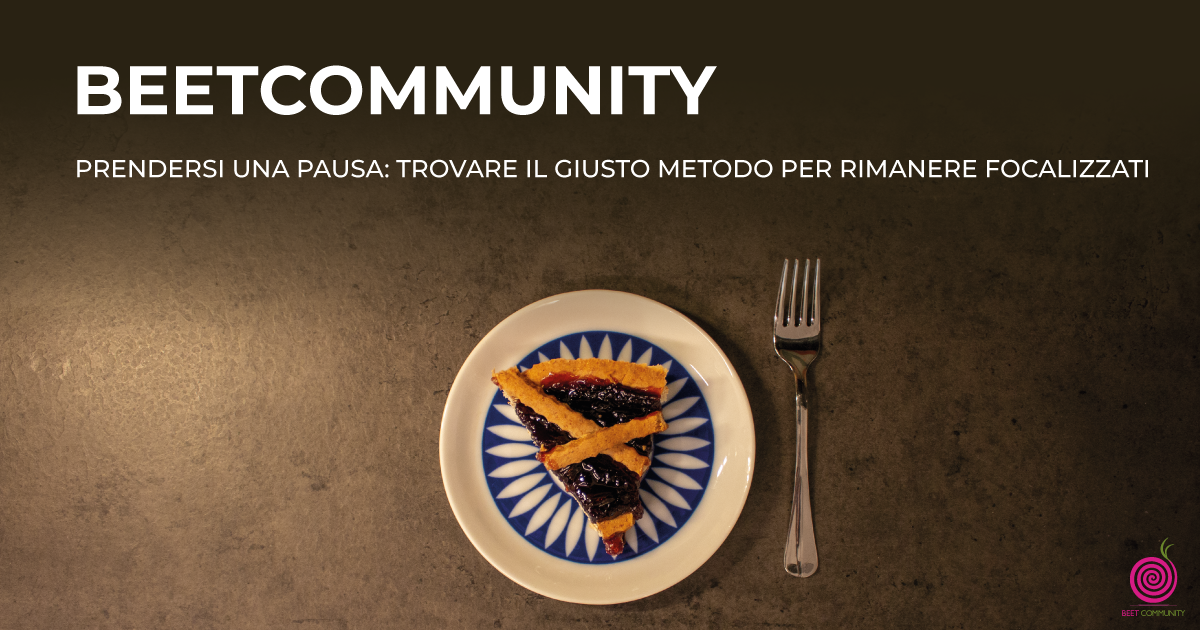Finding the right method to take a break by interrupting work activity and staying focused and more concentrated, increasing productivity.

How pausing work can help you stay focused, increase concentration, and boost productivity.
Everyone needs to take a break to unplug from time to time. That's why it's essential to find the
right work method to stay focused, concentrated, and productive without sacrificing necessary moments of relaxation. Although it may seem contradictory,
briefly interrupting your work actually helps maintain focus, increasing productivity and concentration. This applies even to the most workaholic individuals. In fact, these are often the people who see taking a break as a sign of weakness, but they are the ones who would benefit the most in terms of efficiency and productivity. If their priority is to complete their work excellently and confirm themselves as the best, maintaining focus and concentration is crucial.
How to best achieve your goals
In reality, it’s impossible for anyone to work nonstop without losing something along the way—maybe quality, timing, results, or value. Nonstop work demands great energy expenditure, inevitably causing stress on both body and mind. Under stress, the human mind struggles to work productively and efficiently 100% of the time. Therefore, contrary to common belief,
interspersing work with breaks ensures concentration remains at an optimal level. Regardless of the type of work—physical or intellectual, manual or abstract—introducing some
break moments into your work routine definitely helps you reach your goals more effectively. Not all breaks are equal
It is fundamental not only to find the best moments but also to choose the kind of break that truly serves the purpose. For example, spending a few minutes checking unread emails is not a real break. Even then, the mind remains tied to a work-related stressful state. On the other hand, checking newsletters sent to an email account reserved exclusively for promos or news about hobbies and leisure activities is different.
Choosing the best method
Certainly, being in a workplace—whether an office,
a coworking space, or your home—that allows you to maintain a balanced and calm working style is already a way to keep productivity high. Freelancers, digital nomads, and smart workers generally have an advantage here. For employees who cannot choose their workplace, it becomes even more important to
find a work method balancing the time spent working with the time needed to recharge energy and concentration.
Caveday, a community part of the global network of
WeWork Labs experts, has humorously theorized a sort of “law” explaining the importance of taking breaks at work. It states
The First Law of Work:
"Every act of work gains strength and energy from doing its opposite." Caveday continues explaining that just as writing skill improves the more you read,
concentration grows stronger if you take time to relax. According to this concept,
work becomes better and more effective when you take an adequate break; stopping work for a moment to let your mind breathe is what helps you be more productive, focused, and attentive.
Everyone has their own best way to take a break: some prefer reading the news, others taking a coffee, herbal tea, or a snack, some check the latest posts on social media. In any case, the important thing is to remember to take breaks and schedule them according to your needs.
The Pomodoro Technique
There are actual
techniques designed to help workers not skip their breaks, such as the
Pomodoro Technique. This
work method—named after the tomato-shaped kitchen timer used to track time—
alternates phases of work and breaks. You set a timer for X minutes of work, then take a break of Y minutes as soon as it rings. This cycle repeats throughout the workday. Inspired by this method, Google developed a Chrome extension that changes color and sounds an alarm when each phase ends. The plugin also allows you to block certain URLs, called
Strict Workflow, preventing access to distracting sites (like Facebook, for example) during work phases.
Technology also offers other tools such as apps for computers and phones to remind users to take proper breaks. Some apps remind you to do nothing for two minutes, others suggest “micro breaks” of 10 seconds every 10 minutes, or “normal breaks” of 10 minutes every 50 minutes of work. As mentioned, it’s up to each person to choose the method that suits them best.
If you know other techniques and want to share your experience, or want to learn new ones, join our Facebook group Beetcommunity | Professionals Connected. Interaction is always lively in this space.

